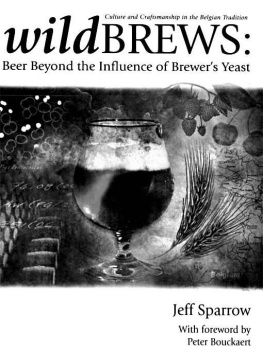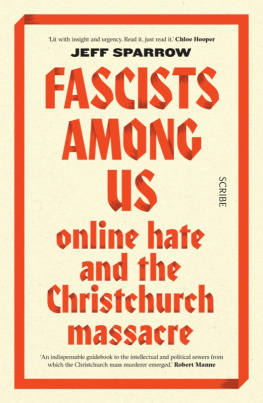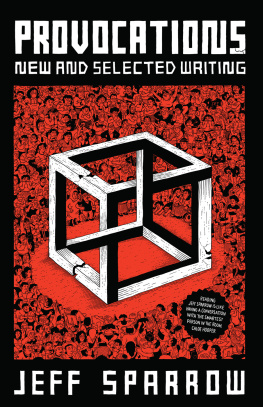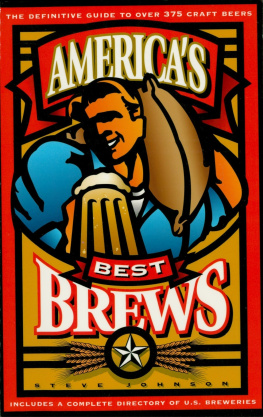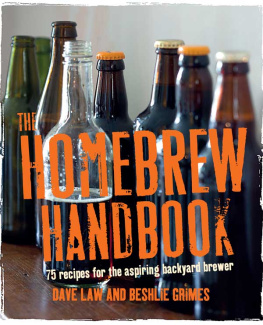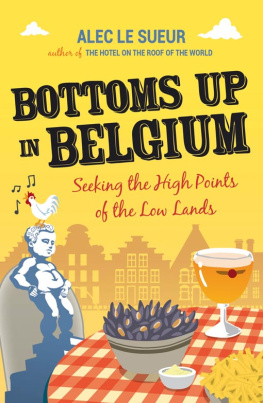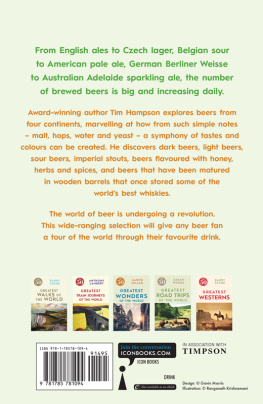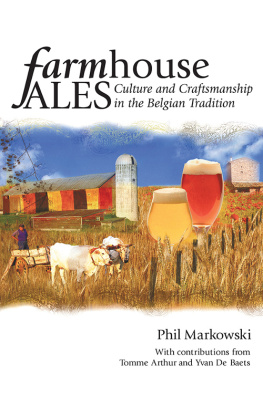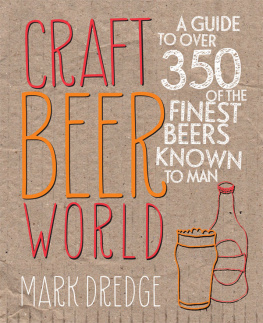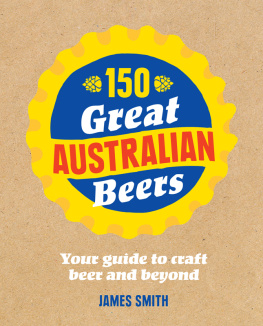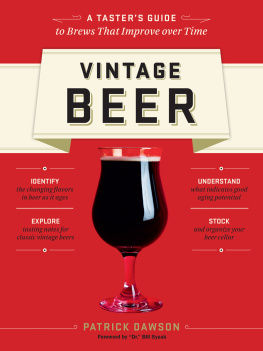Jeff Sparrow - Wild Brews: Culture and Craftsmanship in the Belgian Tradition
Here you can read online Jeff Sparrow - Wild Brews: Culture and Craftsmanship in the Belgian Tradition full text of the book (entire story) in english for free. Download pdf and epub, get meaning, cover and reviews about this ebook. year: 2005, publisher: Brewers Publications, genre: Non-fiction. Description of the work, (preface) as well as reviews are available. Best literature library LitArk.com created for fans of good reading and offers a wide selection of genres:
Romance novel
Science fiction
Adventure
Detective
Science
History
Home and family
Prose
Art
Politics
Computer
Non-fiction
Religion
Business
Children
Humor
Choose a favorite category and find really read worthwhile books. Enjoy immersion in the world of imagination, feel the emotions of the characters or learn something new for yourself, make an fascinating discovery.
- Book:Wild Brews: Culture and Craftsmanship in the Belgian Tradition
- Author:
- Publisher:Brewers Publications
- Genre:
- Year:2005
- Rating:4 / 5
- Favourites:Add to favourites
- Your mark:
- 80
- 1
- 2
- 3
- 4
- 5
Wild Brews: Culture and Craftsmanship in the Belgian Tradition: summary, description and annotation
We offer to read an annotation, description, summary or preface (depends on what the author of the book "Wild Brews: Culture and Craftsmanship in the Belgian Tradition" wrote himself). If you haven't found the necessary information about the book — write in the comments, we will try to find it.
Wild Brews: Culture and Craftsmanship in the Belgian Tradition — read online for free the complete book (whole text) full work
Below is the text of the book, divided by pages. System saving the place of the last page read, allows you to conveniently read the book "Wild Brews: Culture and Craftsmanship in the Belgian Tradition" online for free, without having to search again every time where you left off. Put a bookmark, and you can go to the page where you finished reading at any time.
Font size:
Interval:
Bookmark:

Brewers Publications
A division of the Brewers Association
PO Box 1679, Boulder, CO 80306-1679
www.beertown.org
2005 by Jeff Sparrow
All rights reserved. No portion of this book may be reproduced in any form without written permission of the publisher. Neither the author, editor nor the publisher assume any responsibility for the use or misuse of information contained in this book.
Printed in the United States of America.
10 9 8 7 6 5 4 3 2
ISBN-13: 978-0-937381-86-1
ISBN-10: 0-937381-86-1
Library of Congress Cataloging-in-Publication Data
Sparrow, Jeff, 1965
Wild brews : beer beyond the influence of brewers yeast / by Jeff Sparrow ; with foreword by Peter Bouckaert.
p. cm.
Includes bibliographical references and index.
ISBN-13: 978-0-937381-86-1
ISBN-10: 0-937381-86-1
1. BeerBelgium. 2. Brewing. I. Title.
TP577.S645 2005
641.2309493dc22
2005009055
Publisher: Ray Daniels
Technical Editor: Gordon Strong
Copy Editor: Daria Labinsky
Index: Daria Labinsky
Production & Design Management: Stephanie Johnson
Cover and Interior Design: Julie Korowotny
Cover Illustration: Alicia Buelow
Interior Photos by: Joe Preiser
Contents
T o Chris, who once convinced me to spare a day and visit this tiny place called Beersel and to walk up that blasted hill.
Special thanks to the Belgian and Dutch brewers and blenders who have shared with me the many secrets of their age-old art: Yves Benoit from Brouwerij Bavik; Marina and Marc Limet from Kerkom; Frank Boon from Brouwerij Boon; Jean and Jean-Pierre Van Roy and Yvan DeBaets from Cantillon; Lieven, Steven, and Pieter from Cnudde; Karel Goddeau from De Cam; Kris Herteleer from De Dolle Brouwers; Armand DeBelder from Drie Fonteinen; Paul Rutten from Gulpener Bierbrouwerij; John Matthys and Sidy Hanssens from Hanssens Artisanaal; Filip Devolder from Liefmans; Dirk Lindemans from the Brouwerij Lindemans; Tony Brown from Melbourn Brothers; Bruno Reinders from Mort Subite; Rudi Ghequire from Rodenbach; and Karl Verhaeghe from the Verhaeghe Brouwerij. Please support their art and buy their beers wherever you may find them.
Why do all of these breweries own a cat? To keep the Brettanomyces under control.
Thanks, also, to my friends in the U.S. beer industry whose creativity never ceases to amaze me: Sam Calagione from Dogfish Head Brewing, Mark Edelson from Iron Hill Brewery, Tomme Arthur from Pizza Port, Phil Markowski from Southampton Publick House, Vinnie Cilurzo from Russian River Brewing, Matthias Neidhart of B. United International, Keith Lemke and Lyn Kruger from the Siebel Institute, Chris White from Whitelabs, and Les Perkins and my scientific adviser Dave Logsdon from Wyeast Laboratories.
A special thanks to Peter Bouckaert from New Belgium Brewing, who teaches me something new every time we chat. Peter produces many truly unique beers.
To homebrewer Raj Apte, for his graphic approach to wild beers.
To Gordon Strong, whose eagle-eye editing saved me from a few technical blunders.
A pop of the cork to all of my friends in the Chicago Beer Society, whose friendship and passion are irreplaceable. A special toast to: Joe Preiser, my photographer, driver, and co-founder of the wild beer fraternity; Ray Daniels, who, if I told him how much he taught me, would be surprised I paid attention; Randy Mosher, who discovers the most radical brewing texts one could imagine.
And to Brett, without whom none of this would be possible.
I t was somewhere in 1995 or so. I had shown two brewers, Daryl and David from Boston, around Brouwerij Rodenbach in Belgium. Somehow, we all ended up at my parents home after that. My father had an old bottle of beer in his wine cellar. It was a bottle of seison (Flemish for saisori), brewed in 1945 in Kuurne by Andriesthe last year that brewery had brewed. Daryl somehow convinced my father to open it. Most of the CO2 gas had escaped since the cork had dried and shrunk, but the beer had survived pretty well, flavorwise. My father decided to call the old brewer Ferdinant while we were drinking it, to ask how he made the beer.
Ferdinant was sick in bed and speaking with difficulty. His first reaction to the question of how he brewed the beer was, Your son is brewer, he knows. After we insisted some more, he opened up to us. After the coolship, the beer went in the barrels, where some sugar was added after a while. He also told us that we were crazy to drink this old stuff. Is it any good? He mentioned that his was one of the only breweries in the area that was able to keep its brewing equipment through the Second World War. You know, all the normal stuff. Isnt your son the brewer at Rodenbach? Rodenbach was able to brew through the war. He knows. Since the brewer had a hard time speaking, we did not insist any further.
Was this old brewer talking about a lambic? No, a coolship and wood barrels were pretty standard in smaller breweries at that time in Belgium. Did he add yeast? Brewery Andries was also brewing year-round, different beers, so they might have used yeast from another brew. Maybe he got something from another brewery in the beginning of the winter season, maybe not. Were there other microorganisms added or present? For sure, but it was not really controlled. That was probably why he was referring to me and Rodenbach. In his time, Rodenbach was one of the larger local breweries that focused on wood aging with a mixed yeast culture.
Was this a Wild Brew? No, this was just a normal beer, according to Ferdinant.
Louis Pasteur wrote Etudes Sur la Biere (Studies on Beer) in 1876. Pasteur took a look under his primitive microscope to examine sick-or foul-smelling beer. He saw that, beside ellipsoid cells, many other tiny things were present in the sick beer. He and some other researchers and brewers around this time started to realize that those ellipsoid cells were crucial for the fermentation of beer.
Before 1876, what would a book with the title Wild Brews have meant? We used to have a zoo of microorganisms in brewing, but we did not even realize it. The effect of the other microorganisms was kept under control, with short shelf life, high hop rates, experience, sometimes more alcohol, and some other tricks.
What happened in those one hundred and forty years since Pasteur? We have learned tons about Saccharomyces cerevisiae. But we learned only limited amounts about Brettanomyces, Pediococcus, Lactobacillus, or you name it. We learned even less of the interaction between those critters. And what about the use of the wood vessels we keep them in?
After Pasteur, the use of single yeast cultures spread like wildfire. As in every technological development, there are also late adopters, such as the English ales and Berliner weisse. The brewer from the Andries brewery in Kuurne never adapted this seizoen. And then we have the hedgehogs, clinging furiously to the good old stuff, while the world keeps on turning.
This book talks about the hedgehogs in Chapter One. Jeff struggles to make sense of the information from the brewers he talked with. All of those brewers are like Ferdinant from brewery Andries to an extent. All those brewers are making their beer, in most cases, as their fathers did. What are you really asking for, Jeff? This is how you make beer, you know. All are relying on their experience of what went wrong and right. Those brewers are making their beer, not a style. As Jeff writes: Guilds, imports, local tastes and terroir were all contributing factors to the individual character of Belgian beers.
Chapter Two in Wild Brews is digging up those fossilized beers that used to roam the world. Im amazed at the amount of information in there. Belgian brewing history is not very well documented. In the following chapters Jeff tastes beer, looks more closely at the microbiology and the brewing process, and ends with suggestions on how to recreate those wild brews.
Next pageFont size:
Interval:
Bookmark:
Similar books «Wild Brews: Culture and Craftsmanship in the Belgian Tradition»
Look at similar books to Wild Brews: Culture and Craftsmanship in the Belgian Tradition. We have selected literature similar in name and meaning in the hope of providing readers with more options to find new, interesting, not yet read works.
Discussion, reviews of the book Wild Brews: Culture and Craftsmanship in the Belgian Tradition and just readers' own opinions. Leave your comments, write what you think about the work, its meaning or the main characters. Specify what exactly you liked and what you didn't like, and why you think so.

